[ad_1]
Thanks to their distinctive looks and marginal care requirements, aquarists have found appeal in freshwater catfish. While a few types of aquarium catfish are pretty aggressive in nature, most are suitable for community tanks.
The name “catfish” originated from the presence of prominent barbels on the head and around the mouth of the fish. Their resemblance to cat whiskers is deemed to be the reason behind the vernacular nomenclature.
In this article, we’ll go through a few types of aquarium catfish and discuss their origin, appearance, characteristics, and special tank requirements. Other details, such as water parameters and species-specific diet, are mentioned in the tables.
10 Types of Aquarium Catfish
1. Suckermouth Catfish
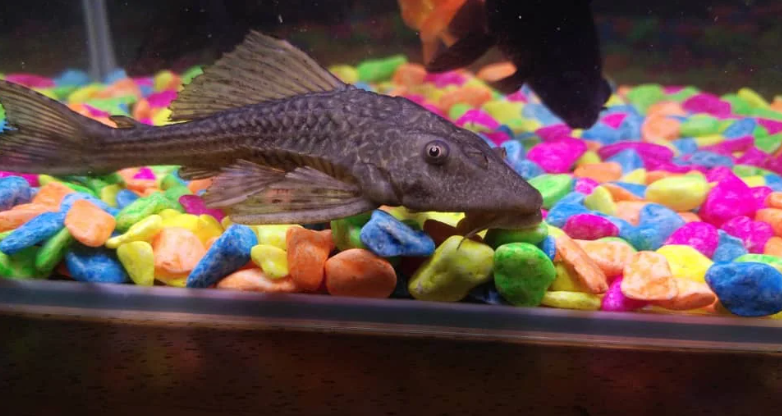
| Scientific Name: | Hypostomus plecostomus |
| Family: | Loricariidae |
| Care Level: | Easy to Moderate |
| Temperament: | Peaceful. Can become aggressive. |
| Color: | Dark brown or black |
| Lifespan: | 10 to 15 years |
| Size: | 16 to 20 inches |
| Diet: | Herbivorous. Feeds on Algae, sinking pellets. |
| Minimum Tank Size: | At least 75 gallons. More with increasing size. |
| Temperature: | 72 to 82F |
| Water Conditions: | pH 6.5 – 7.5 Low to moderate hardness |
| Tank Mate Compatibility | Peaceful fish |
Known as the Common Pleco, the Suckermouth Catfish is native to the Amazon River basin and Orinoco River basin, and in countries such as Peru, Columbia, and Brazil. Owing to their distinctive appearance and algae-eating abilities, they can now be found in aquariums all over the globe.
The Suckermouth has a flattened body with bony flakes covering the upper side of the body. While they typically exhibit a black or brown body, lighter colors with dark patterns also are prevalent. They grow pretty fast and require larger tanks to sustain them.
Common Plecos are nocturnal creatures. They’re primarily active during the night and often stay hidden behind the decorations and lay flat on the substrate during the day. Their suckers, designed to stick to glass, gravel, and smooth rocks, help them fulfill their appetite for algae.
They typically display solitary behavior and don’t form groups when kept together. But they are easygoing with other tank mates. In maturity, when they’ve grown to a significant size, they may develop territorial aggression.
Despite being efficient algae-eaters, Suckermouths become less effective as they grow older. Ensure to supplement their diet with sinking pellets and algae flakes. Adequate filtration and frequent water changes are a must to sustain pleco tanks.
2. Cory Catfish
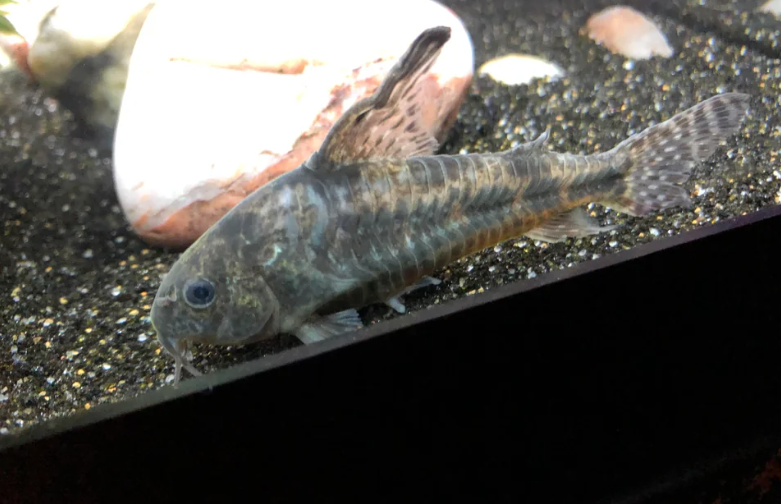
| Scientific Name: | Corydoras paleatus |
| Family: | Callichthyidae |
| Care Level: | Easy to moderate |
| Temperament: | Peaceful and social |
| Color: | Various colors with light or dark markings |
| Lifespan: | 5 to 10 years |
| Size: | 2 to 3 inches |
| Diet: | Omnivorous. Small insects, sinking pellets, and live foods. |
| Minimum Tank Size: | 20-gallon for a small group |
| Temperature: | 72 to 78F |
| Water Conditions: | pH 6.5 – 7.5 Low to moderate hardness |
| Tank Mate Compatibility | Peaceful non-aggressive species |
Originating from the South American basins, rivers, and streams, the Cory Catfish has 160 known species inhabiting freshwater aquariums. Mostly known for their quirky behaviors, this catfish species is a very popular choice for community aquariums.
Cory Catfish are small and have developed a charming appearance through their armored plating, lighter colors, and dark spots all over. They also have specially designed barbels to sift through the substrate in search of food. Therefore, it’s recommended to use soft sandy substrates in Cory tanks.
This catfish species prefers a well-planted tank with lots of hiding spaces like driftwood, rocks, and caves. Individually, they’re pretty peaceful and harmless, but they thrive in small groups. Belonging to a group reduces stress and helps them be more quirky.
Keep at least 6 Cory Catfish together to observe their amusing shoaling behaviors.
They also are great for community tanks and are pretty efficient algae-eaters. But, they occasionally release toxins to deter potential predators or aggressive tank mates.
A particular endearing behavior called “Cory shimmy” can be observed in a group of Cory Catfish. As a method of communication and showing contentment, they wiggle their bodies and shake their fins.
3. Pictus Catfish
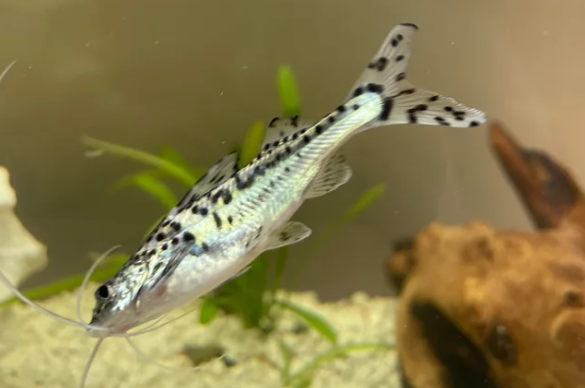
| Scientific Name: | Pimelodus pictus |
| Family: | Pimelodidae |
| Care Level: | Easy to moderate |
| Temperament: | Peaceful. Semi-aggressive in isolation. |
| Color: | Silver or gray. Covered in spots and stripes. |
| Lifespan: | 5 to 8 years |
| Size: | 4 to 5 inches |
| Diet: | Omnivorous |
| Minimum Tank Size: | 30 gallons for a single fish. More for a group. |
| Temperature: | 72 to 80F |
| Water Conditions: | pH 6.5 to 7.5. Water hardness in the low range. |
| Tank Mate Compatibility | Other peaceful fish species. |
Pictus Catfish are native to Amazon and Orinoco River basins, found in countries such as Columbia and Venezuela. Although breeding is possible, it’s challenging and avoided even by experienced aquarists. Therefore, most juvenile Pictus Catfish are caught in the wild.
Appearance-wise, Pictus are one of the most striking types of aquarium catfish. They exhibit a sleek and elongated white or silver body with dark spots and stripes all over their body and fins. Their natural sheen is complemented with long barbels and gracious whisker-like features.
In their natural habitat, they prefer to sift through the sandy and muddy river beds in search of food. In artificial waters, you need to provide them with similar substrate choices to mimic their natural behavior.
These nocturnal catfish stay active during the night and prefer to take rest during the day. Make sure to provide enough hiding spaces for them in the form of driftwood, rocks, and decorations. Being exploratory in nature, they can be seen darting around the tank and exploring the environment.
Pictus Catfish are shoaling fish and prefer to live in a group of at least three. A group allows them to exhibit shoaling behavior and gives them a sense of security—reducing stress. In community tanks, pair them up with other fast-moving, peaceful fish.
The vocal abilities of Pictus, called “croaking”, sets them apart from other catfish species. They tend to make cracking sounds by grinding their pectoral spines together to communicate and express happiness.
4. Glass Catfish
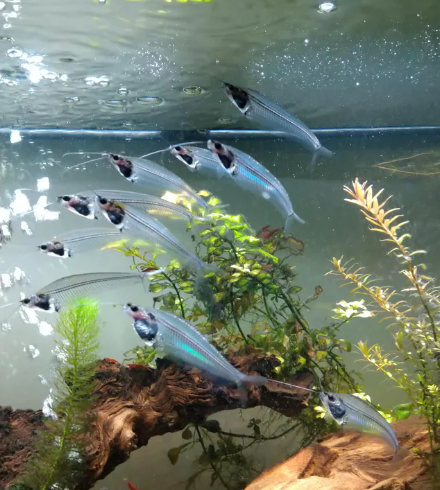
| Scientific Name: | Kryptopterus bicirrhis |
| Family: | Siluridae |
| Care Level: | Moderate |
| Temperament: | Peaceful and shoaling. |
| Color: | Translucent glass-like appearance. |
| Lifespan: | 3 to 5 years |
| Size: | 3 to 4 inches |
| Diet: | Omnivorous |
| Minimum Tank Size: | 20 gallons for a small group. More, if required. |
| Temperature: | 75 to 82F |
| Water Conditions: | pH 6.0 to 7.5 Low hardness. |
| Tank Mate Compatibility | Other peaceful species |
Found mostly in slow-moving rivers and streams in Thailand, Malaysia, Indonesia, and other countries in Southeast Asia, the Glass Catfish, aka Ghost Catfish, are popular among aquarists for their unique and captivating appearance.
Glass Catfish, as the name suggests, is transparent or translucent in appearance. You can observe their digestive tract, swim bladder, and other internal organs through their bodies.
A slender shape, forked tail, and large reflective eyes also contribute to their overall appeal.
This catfish species is typically pretty peaceful and keeps to themselves when it comes to individual behavior. However, they prefer to stay in groups of six and practice natural shoaling behavior and reduce stress.
Being shy creatures, Ghosts also prefer having a lot of hiding spots to explore and escape. Ensure to mimic their natural habitat by providing dense vegetation, floating plants, driftwood, and other decorations.
Leveraging their transparent body, consider introducing a dark, sandy substrate to increase contrast and enhance their visibility. However, being predominantly nocturnal, you may not be able to fully celebrate their striking appearance and shoaling behaviors during the day.
Glass Catfish also are known for their unique swimming style. Their slightly tilted swimming behavior gives them an almost hovering appearance—making them more dazzling in your aquarium.
5. Upside-Down Catfish
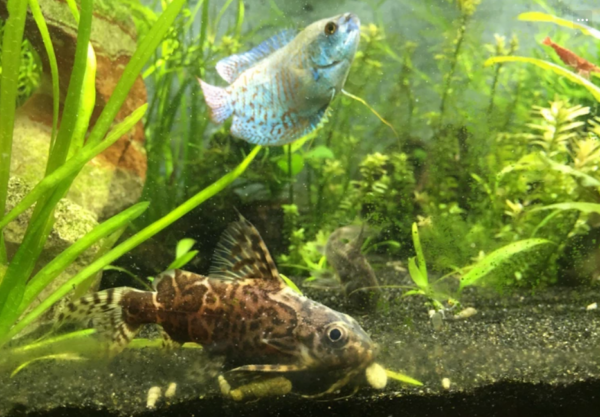
| Scientific Name: | Synodontis nigriventris |
| Family: | Mochokidae |
| Care Level: | Easy to moderate |
| Temperament: | Peaceful and sociable. |
| Color: | Dark body with a white belly. |
| Lifespan: | 5 to 8 years |
| Size: | 3 to 4 inches |
| Diet: | Omnivorous |
| Minimum Tank Size: | 20 gallons for a small group |
| Temperature: | 72 to 82F |
| Water Conditions: | pH 6.5 to 7.5 Low water hardness |
| Tank Mate Compatibility | Peaceful fish species |
A fascinating species, the upside-down catfish, is found in parts of Africa, especially in the Congo River basin and other nearby river systems.
They’ve evolved to develop larger pectoral fins and asymmetrical swim bladders slightly moved towards their head to give them the ability to swim upside-down and eat algae from under the rocks, plants, and from the water surface in their natural setup.
However, they also can swim straight up if they choose to.
Upside-Down Catfish has a flattened body with a light beige and silver coloration with a lighter color or white underbelly. Dark horizontal stripes also are visible in most individuals. Typical with other catfish species, they also have barbels on their head.
This nocturnal catfish species is known to be quite peaceful and prefer large groups to swim around. In the wild, they keep close to each other to feel safe and protect each other from predators.
You may also keep them in community tanks with lots of hiding spaces without any issues. However, make sure to provide them with driftwood, lots of plants, and rocks to hide and explore.
Although they prefer eating from the water surface, they also love scavenging for food. Another unique trait of Upside-Down Catfish may be their ability to directly extract atmospheric air with their modified intestine, which makes them able to survive even in low-oxygenated waters.
6. Redtail Catfish
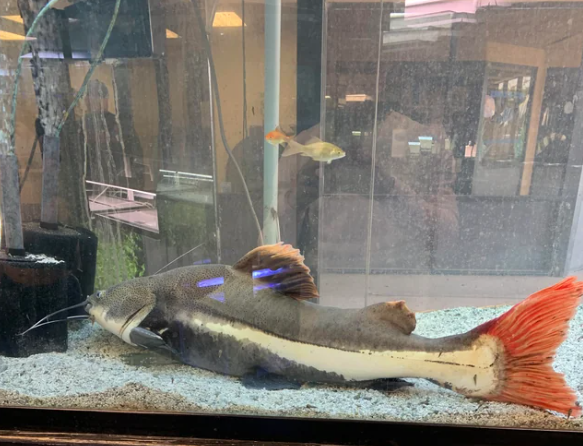
| Scientific Name: | Phractocephalus hemioliopterus |
| Family: | Pimelodidae |
| Care Level: | Moderate to difficult |
| Temperament: | Highly predatory and aggressive as they mature |
| Color: | Gray or black body with a vibrant red tail and white underbelly |
| Lifespan: | 15 years |
| Size: | 2 to 4 feet in captivity |
| Diet: | Carnivorous. Frozen food, live fish, shrimps, worms |
| Minimum Tank Size: | 1000 gallons or more. Preferably a pond. |
| Temperature: | 72 to 82F |
| Water Conditions: | pH 6.5 to 7.5 Low hardness |
| Tank Mate Compatibility | Should be kept alone |
Redtail Catfish, commonly known as RTC in the aquarium community, is one of the largest carnivorous catfish species able to survive and thrive in captivity. Originating in the Amazon and Orinoco River basins in South America, they’re popular among veteran aquarists and breeders.
The most striking feature of the large, elongated body of Redtails is their vibrant red tail fin. More enhanced in juveniles, the red tails, and fins often become less vibrant as they mature. However, an olive-brown body and light underbelly also add to their overall charm and grace.
As they grow exceptionally large, the Redtails can’t be kept in average aquariums. You need to arrange for a pretty large aquarium or even a pond to house them permanently. Being carnivorous predators, you also need to be resourceful about food and its sustainability.
Redtails are generally solitary fish, and they’re mostly found alone in the wild. However, in a predator tank, they may become aggressive toward other tankmates. Therefore, it’s recommended to keep them in a separate tank once they’ve reached a certain size and age.
Contradictory to popular beliefs, Redtail Catfish require a lot of hiding space in the form of caves, rocks, and driftwood. If you’re including natural rocks, ensure that the crevices are smooth and large enough for the Redtail to move around.
7. Striped Raphael Catfish
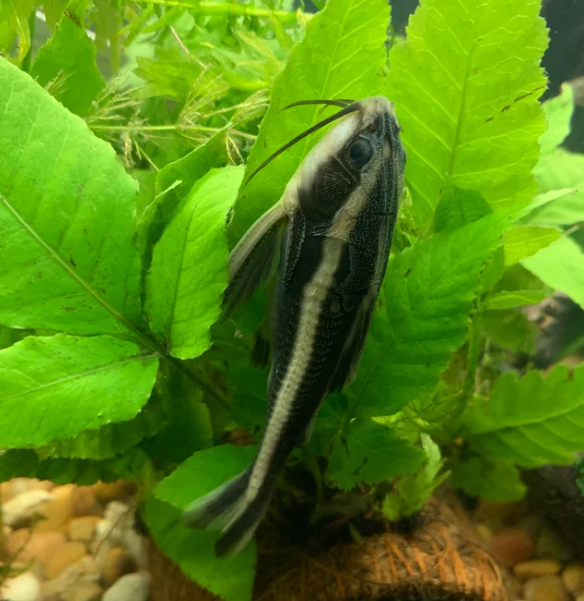
| Scientific Name: | Platydoras armatulus |
| Family: | Doradidae |
| Care Level: | Easy to moderate |
| Temperament: | Peaceful, nocturnal. |
| Color: | Dark body with light stripes. |
| Lifespan: | 8 to 15 years |
| Size: | 6 to 8 inches |
| Diet: | Omnivorous |
| Minimum Tank Size: | 30 gallons |
| Temperature: | 72 to 79F |
| Water Conditions: | pH 6.5 to 7.5 Low water hardness |
| Tank Mate Compatibility | Peaceful community fish |
Native to the Amazon and Orinoco River basins in South America, the Striped Raphael Catfish, aka Three-Bearded Catfish, is an extraordinary addition to any freshwater community aquarium.
Generally kept as bottom dwellers to clean substrates, the Striped Raphael is equally handsome and active. They exhibit a brown to black body covered in horizontal stripes running from head to tail. The elongated body shape of Raphael, paired with three pairs of barbels, makes them efficient scavengers.
In terms of characteristics, they’re nocturnal and pretty shy around other fish. They prefer hiding behind rocks, plants, and driftwood in the daytime and become more active at night when they sift through the substrate for food.
As for substrate choice, light sands work best for Raphaels, but if you prefer having plants in your tank, black soil also is a viable option.
When added to community tanks, preferably in a group of 6, try to pair them up with other peaceful community fish. Despite their peaceful nature, they can become quite aggressive towards other fish species if startled.
Some aquarists refer to them as night watchmen due to their nocturnal activities and playfulness. Use dim lighting settings if you also want them to demonstrate their schooling activities during the day.
8. Dwarf Suckers
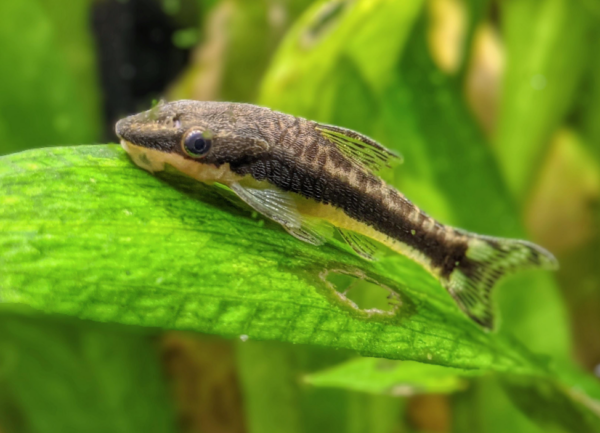
| Scientific Name: | Otocinclus affinis |
| Family: | Loricariidae |
| Care Level: | Easy to moderate |
| Temperament: | Peaceful and social |
| Color: | Dark body with light-colored striped |
| Lifespan: | 3 to 5 years |
| Size: | 1.5 to 2 inches |
| Diet: | Herbivorous |
| Minimum Tank Size: | 10 gallons for a small group |
| Temperature: | 72 to 79F |
| Water Conditions: | pH 6.5 to 7.5 Low water hardness |
| Tank Mate Compatibility | Small schooling fish and peaceful community fish |
Dwarf Suckers are native to South America, especially found in the Amazon River basin and its tributaries in countries such as Brazil, Peru, and Columbia. Mimicking their natural habitat, they prefer soft substrates like sand or fine gravel to easily access food beneath them.
They generally inhabit slow-moving rivers and streams with lots of vegetation and hiding spots like tree branches and roots. Therefore, keeping them in a planted aquarium with driftwood and rocks is recommended.
Dwarf Suckers are small catfish with slender bodies covered in bony plates, giving them a tough appearance. While their bodies are mostly silver with irregular patterns of dark spots visible, their eyes have a vibrant red hue—setting them apart.
This catfish species is generally non-aggressive and exhibits playful behavior towards their own and other tank mates. Being nocturnal, their activities heightened at night. However, they’re best kept in a group of 5 to promote a sense of security and reduce stress.
If you decide to keep them in community tanks, ensure to mate them up with other small schooling fish and peaceful community fish, such as Tetra, small Cichlids, and Guppies.
Dwarf suckers are efficient algae-eaters. Most aquarists prefer them for their ability to manage algae growth in the tank. However, be careful when handling them because of their sharp pectoral spines.
9. Bronze Corydoras
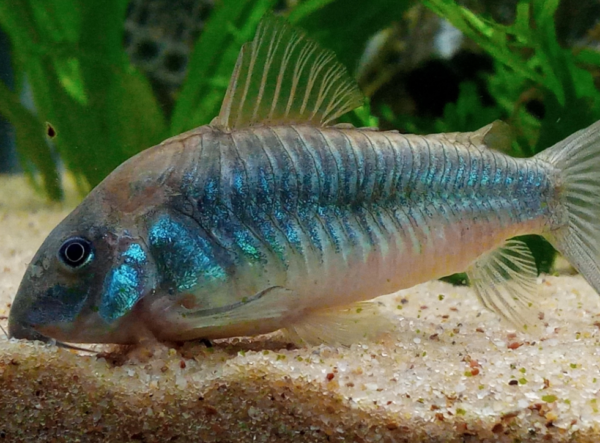
| Scientific Name: | Corydoras aeneus |
| Family: | Callichthyidae |
| Care Level: | Easy |
| Temperament: | Peaceful and social |
| Color: | Greenish body with a white underbelly |
| Lifespan: | 5 to 7 years |
| Size: | 2.5 to 3 inches |
| Diet: | Omnivorous |
| Minimum Tank Size: | 20 gallons for a small group of 5 |
| Temperature: | 72 to 78F |
| Water Conditions: | pH 6.0 to 7.5 Low to moderate water hardness |
| Tank Mate Compatibility | Peaceful community fish |
Bronze Cory, Green Cory, or Bronze Corydoras are native to the Amazon and Orinoco River Basin. But are also found in the coastal rivers of Trinidad and Tobago. They prefer softer substrates, including sand and fine gravel, mimicking their natural environment.
Moreover, as they live in slow-moving water with lots of vegetation, fallen leaves, and submerged branches, aquascapes with driftwood, live plants, and smooth rocks are ideal for them.
Bronze or metallic green in color, the Bronze Cories are small, peaceful fish with a light-colored belly and horizontal stripes running along their body. They’re covered in overlapping plates, which gives them a protective armor-like appearance and safety from predators.
Typically bottom-dwellers, the Green Cory are peaceful in nature and love being around their own. We recommend keeping at least 5 individuals to offer them a sense of safety. Therefore, reducing stress.
Keeping Bronze Cory requires investing in good filtration, as they’re quite sensitive to parameter changes. While they mostly are scavengers, sinking flakes, and frozen foods should also be offered to fulfill their nutritional requirements.
Like many catfish, this species also are air breathers and possess a unique adaptation called “suprabranchial organ,” which allows them to gulp air from the surface for additional oxygen requirements.
10. Tiger Shovelnose Catfish
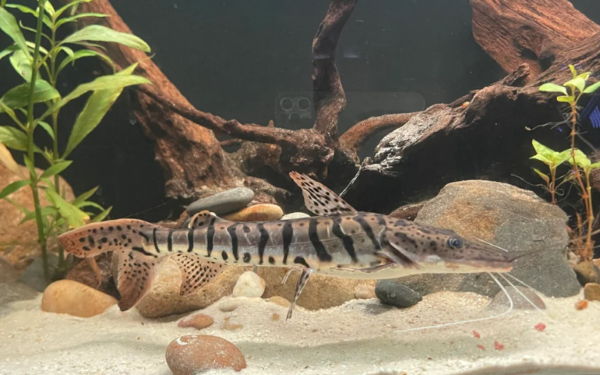
| Scientific Name: | Pseudoplatystoma fasciatum |
| Family: | Pimelodidae |
| Care Level: | Advanced |
| Temperament: | Aggressive and highly predatory |
| Color: | Silver body with tiger-like stripes |
| Lifespan: | 10 to 15 years in captivity |
| Size: | 2 to 3 feet |
| Diet: | Carnivorous. Small fish, crustaceans, meaty food, shrimp, worms |
| Minimum Tank Size: | 300 gallons. Preferably a pond. |
| Temperature: | 72 to 80F |
| Water Conditions: | pH 6.0 to 7.5 |
| Tank Mate Compatibility | Should be kept alone |
Found in river systems across Brazil, Peru, and Venezuela, and native to the Amazon River basin, the Tiger Shovelnose Catfish is a huge species that has species-specific needs and requires advanced care. As the species demands long-term commitment, only experienced aquarists are advised to keep them as pets.
Shovelnoses have a striking appearance, with a long flattened body and a broad shovel-like snout. Its body usually is light-colored, mostly yellow and light brown, with dark stripes resembling the appearance of a tiger. Their carnivorous diet advocates the same.
This catfish species prefers to live a solitary life and are powerful predators. Equipped with sharp teeth, they have a large mouth to consume smaller fish and invertebrates. Despite their size, they’re agile swimmers and require tanks with ample swimming space.
In captivity, they can be kept in large predator tanks with similar aggressive and predatory fish who can withstand their natural instincts. However, be mindful to employ powerful filtration systems when keeping Shovelnose Catfish, as they produce huge bioload.
If you can sustain proper nutrition, water conditions, and care, your shovelnose can live several decades in captivity. However, you may see reduced daytime activity as they mature to develop more nocturnal habits.
As for tank setup, apart from providing a large tank, use soft substrates like sand and soft gravel for them to perform bottom-dwelling activities safely. Despite their size and aggression, Tiger Shovelnose Catfish are among the most popular types of aquarium catfish.
FAQs
Yes, catfish are good for your aquarium. While not every type of catfish is suitable for every aquarium, they can help you manage algae growth and keep your tank clean, without needing any extraordinary care.
Most catfish are easy to keep and are pretty hardy fish. However, the Common Pleco and Cory Catfish are the two most easy-going catfish species.
Redtail Catfish and Tiger Shovelnose Catfish are the two most challenging catfish species to care for. Due to their huge size and carnivorous diet, they require long-term commitment and special care. They also need to be kept in specialized community tanks to thrive.
The Bottom Line
While a few of them require advanced care, catfish are generally quite easy to care for. We’ve discussed a few aquarium catfish species that you can keep as pets, and hopefully, you’ll now be able to choose your next bottom-swelling friend pretty easily.
[ad_2]
Source link
